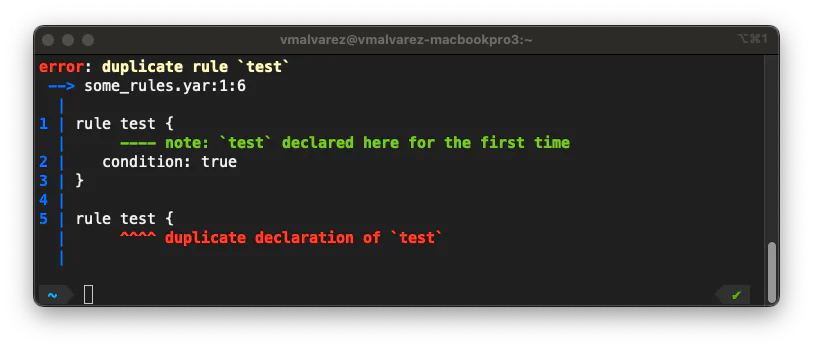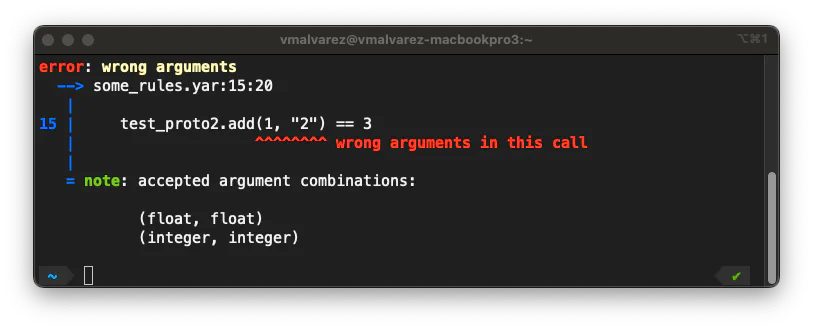YARA-X vs YARA
YARA-X intends to be the replacement for YARA, and it has been designed with usability, backward-compatibility, and performance in mind. YARA-X is already better than YARA in many aspects, but it’s still very young and therefore some features are not implemented yet, and there are rough edges that need to be polished. This section covers the pros and cons of YARA-X versus YARA.
The good things
Let’s start by talking about the things that YARA-X does better. If you prefer seeing the glass half-empty go to the bad things section.
Better error reporting
Error reports in YARA-X are much more detailed and explicative. Each error message tries to provide as much context about the error as possible, which improves the user’s experience. They also look better, as you can see below.


More powerful CLI
YARA-X’s command-line interface (CLI) provides several advantages compared to its YARA counterpart:
- Colorful output, enhancing readability if the terminal supports it.
- More information about the files being scanned.
- Autocompletion support for multiple shells, including Bash, Zsh, and PowerShell, improving usability and efficiency during command entry.
- Access to the output of YARA modules in YAML and JSON formats without requiring any YARA rule. This capability transforms YARA-X into a versatile file dissection tool supporting multiple file formats, like PE, ELF, Mach-O and LNK (Windows link file).
Higher overall performance
YARA-X’s is better than YARA when dealing with regular expressions and complex hex patterns. Let’s use the following rule for detecting Bitcoin addresses as an example:
rule bitcoin_address {
strings:
$btc = /(bc1|[13])[a-zA-HJ-NP-Z0-9]{25,39}/ fullword
condition:
$btc
}The rule above is very slow in YARA. In fact, YARA complains about this rule with a warning like:
warning: rule "bitcoin_address" in bitcoin.yar(3): string "$btc" may slow down scanningIf you scan a relatively large file (let’s say ~200MB), this rule will take more than 20 seconds in YARA, but less than a second in YARA-X.
Similarly, rules with extensive loops, like the following example, perform significantly faster in YARA-X compared to YARA. This rule will be 5-6x faster in YARA-X than in YARA:
rule cafebabe {
condition:
for any i in (0..filesize-1) : (
uint32(i) == 0xCAFEBABE
)
}Notably, not all rules benefit from YARA-X’s optimizations. Rules that are already optimized for performance, and only use plain text patterns or simple hex patterns, are likely to run faster in YARA. This is because YARA is still around 2-3x times faster than YARA-X at raw scanning speed (i.e. the inner loop of the Aho-Corasick algorithm is faster in YARA). However, when encountering a mixture of heterogeneous rules, the worst rules are the ones that dominate the scanning time, often slowing down the process by a factor of 10x or more. As YARA-X is much better at handling those slow cases, the overall performance is usually better.
There’s room for improvement here, and the goal is making YARA-X faster than YARA in all cases.
Parser re-usability
One of the problems with YARA was its monolithic design. The parser was so integrated with the rule compilation logic that it was impossible to reuse it for other purposes, like code formatting tools, linters, etc.
Consequently, numerous alternative YARA parsers have emerged over time, such as [1], [2], [3]). But maintaining those parser in-sync with the official one is hard, and very often they lag behind.
YARA-X, in contrast, has a more modular design, where the parser is decoupled from the rule compilation logic, allowing the reuse of the parser for other purposes.
The bad things
Of course, not everything is great. YARA-X has some drawbacks that we need to discuss too. Some of the drawbacks are related to the lack of features that YARA already has, but YARA-X does not. These may be eliminated in the future as YARA-X matures.
Incompatible APIs
The YARA-X C/C++, Python, and Golang APIs are not compatible with their YARA counterparts. YARA-X is not a drop-in replacement for YARA, you will need to adapt your own programs to the new API.
However, the APIs are conceptually similar, and the migration process should be very simple in most cases.
No process scanning
Process scanning is not implemented in YARA-X yet. This may change in the future if this feature has enough demand. For the time being it’s a low priority feature, but let us know if you really want process scanning implemented.